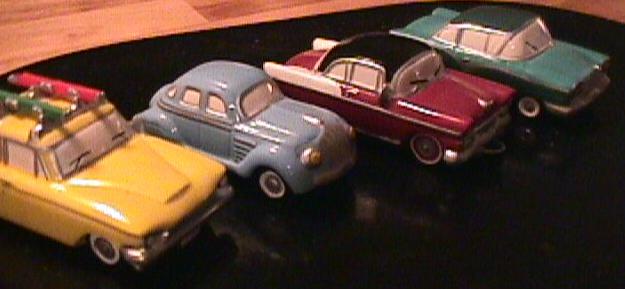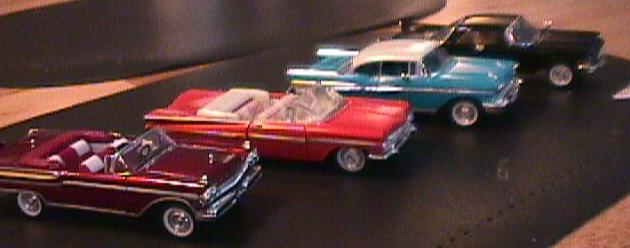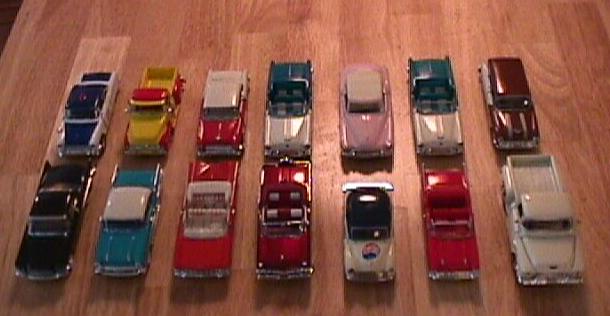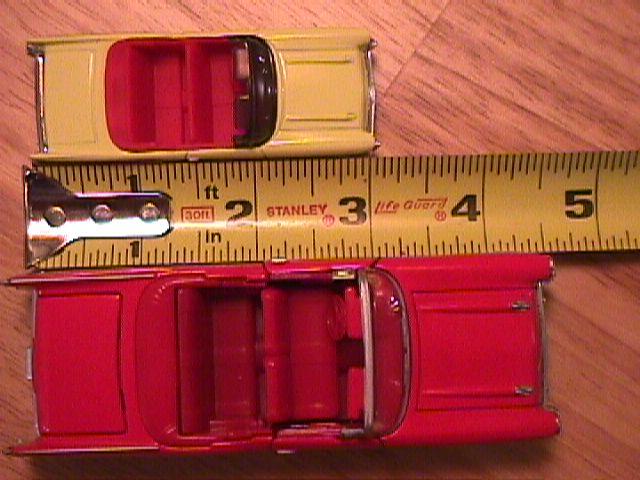

Q: Why 1/43 scale?
A: Because that is the scale of the Department 56 Snow
Village. Actually, to
be completely accurate, the Snow Village ( or any of
D56's villages) isn't really to any scale. In fact, one of the first problems
that a village idiot who is setting up the snow village runs into is dealing
with the total lack of scale in the village. (See Pic 1)

PIC 1
I put together the scene above to illustrate my point about scale and to demonstrate some of the common problems in dealing with it. Take a look at the pizza delivery girl. She's huge! She's about to smash her head into the awning above the door, and I hope those folks inside are hungry because that pizza she's carrying is as big as the door! To her right and left are some of the Department 56 accessories designed to be used with the Snow Village. On her left are the old accessories: a parking meter and a fire hydrant. As you can see, they are designed to be in scale with her but not with the building. The fire hydrant is halfway up the door, and the parking meter three-quarters of the height of the door. Imagine reaching up to put a quarter into that thing. Of course, that's not a problem for our giant Pizza Lady, but this begs the question: why didn't these giant people in this town build themselves bigger buildings? Or at least make taller doors?
Well, there is no answer to that one. As you can see, the parking meter is designed with the scale of the people and the cars in mind, not the scale of the buildings. Department 56 must have caught on to this problem because they have just introduced new accessories, and they are smaller scale. The new parking meter and fire hydrant are to her right, and as you can see they are now more in line with the building but not with the people. On the far right, I placed a true HO scale fire hydrant in the picture so that you can see the difference.
A modern town needs cars, but where to get them? Well,
Department 56 has a partial solution to that problem with their ceramic
cars designed to go in the village. (See Pic 2)

PIC 2
These cars are neat and they have a charm all their own. I use all the ceramic cars I have in the village. The drawback is that they look like they are ceramic, (because they are) not like real cars. In addition, until this year they weren't designed to look like any particular cars, and they too are not really in proper scale. There aren't enough cars in the Department 56 product line to fill the space in the village. It didn't take me long to figure out that I was going to have to go to an outside source to fill the transportation needs of my village.
"HOW BIG?" The first question I encountered in trying
to find more cars to go in my Snow Village was: How big should they be?
After considerable research and analysis I came to the conclusion that
the closest scale that worked well in all situations would be 1/43; 1 inch
on the model = 43 inches on the real car. Fortunately for me, and for all
of you village idiots out there, 1/43 is becoming a very popular scale.
There are a large number of models to choose from
produced by several different manufacturers. (See Pic
3)

PIC 3
As you can see from the pic above, there are a number
of interesting makes and models from which to choose. The cars in this
pic are, from left to right; the 1957 Mercury Turnpike Cruiser, the 1959
Chevy Impala Cabriolet, The 1957 Chevy Bel Air, and the 1957 Chrysler 300.
The Mercury, Bel Air, and Chrysler are all available in a set called "The
Class of 1957," made by ERTL. The Chevy Impala is made by Road Champs.
These are just a few of the 1/43 diecast cars I have
in my village. I'll be sharing pix of the other cars with you later, as
collecting 1/43 as become a hobby in itself. Ok, so now we have our cars,
and as you can see from pic 4 the cars work very nicely in the village
with the buildings.

PIC 4
The scene above shows the buildings and accessories for
the village all set up and working with the 1/43 scale die cast cars in
place. The car in the center isn't die cast; it's one of the new
ceramic cars made by Department 56 for the village. This car is the Ford
Fairlane, and as you can see, it's not quite 1/43 scale but it's very close.
So close, in fact, that you would probably have not noticed it if I hadn't
pointed it out. The other two cars are made by Road Champs. So, here is
the beginning of our scene, and so far it looks perfect. It's obvious that
1/43 scale die cast is going to work great for the village.

PIC 5
Pic 5 shows the beautiful detail and workmanship of a
typical 1/43 scale die cast model.

PIC 6
The above pic shows my entire collection of scale die cast to date. (I say "to date" because, as we speak, I have three more models on the way. I'll be sharing new pix of my latest acquisitions as they arrive.) The white truck on the right isn't 1/43; it's something odd like 1/39, and you can see when it's placed with the other vehicles that it doesn't really fit. Fortunately, this difference isn't noticeable when it's in the village. You can also see how having a village is a much nicer way to display a collection of die cast cars than just having them in a group like this.
"HOW OLD?" The next question that a village idiot working to set up a nice village scene (or diorama) will want to think about is: In what period is the scene set? Well, this is where villaging gets interesting; because there are many different kinds of villages to choose from -- each one set in it's own unique time period. The Snow Village buildings have the look of 1930 - 1940 construction with more modern buildings from the 50's and 60's thrown in. So you can choose to make your Snow Village fit any period from the Thirties on, all the way to 2000 and beyond if you want to. Look at Pic 4 to see how the different architecture of the buildings go together to make a realistic scene. I have decided to set my village in the 50's, and so all of my cars (save one) are from that era, and I discuss that one in greater detail in the Dept. 56 Village Article elsewhere on this web site.
HOW BIG IS 1/43 SCALE? (see Pic 7)

PIC 7
A length of a 1/43 scale model car is usually around 4 3/4". So, if you're checking out a car (maybe online or mail order) to use in your village, and the scale is not included, look for the length and maybe the width. If it's over 4 1/2" and under 5", it's most likely 1/43 scale. Keep in mind that models that are properly scaled should not all be exactly the same, just as the real cars they represent aren't all the same. For example, a 1/43 scale model Corvette should be shorter than a 1/43 scale model Chevy Impala.
"WHAT IS SCALE?" Scale, simply put, is a ratio between the size of a large object and small object designed to represent the large one. 1/43 means a ratio of 1:43 or 1 unit = 43 of the same units, in this case inches. Remember that the larger the second number is, the smaller the object is. This makes sense when you remember that the second number represents the real-life object. (There isn't room for 43 inches on the model as it's only 4 3/4 inches long, so the 1 has to be representing the model side and the 43 the real side.) This means that we can extrapolate the average length of a car from our knowledge of scale models. The average 1/43 scale model length is 4.75", and we know that each of those model inches equals 43" of the real object. Therefore, the length of a real car is 4.75" x 43" (204.25") and 204.25" divided by 12" is approximately seventeen feet. So, now you know the approximate length of a 59 Chevy Impala. If you want to take a tape measure and measure your car, I'll bet it will be come out to something reasonably close to that figure. You can also find out exactly how long a 1/43 scale model of your car would be.
"ARE PLASTIC SCALE MODEL CAR KITS 1/43 SCALE?" No, most plastic model kits are around 1/25 scale, which is way too big for the village (but probably about right for our giant pizza lady.) Check the box of a kit you think you would like to use before buying; you might find one that's 1/43 scale, but I would think it's rare. 1/43 is small; a model kit of that size would be beyond the skill of most model builders.
"WHAT IS THE DIFFERENCE BETWEEN HO SCALE AND 1/43?" HO
scale is a symbol representing approximately 1/66 scale (for cars.) HO
or (1/66) is about the scale of Matchbox cars (see Pic 8.) I have a whole
section dedicated to HO scale elsewhere on this web site.

PIC 8
The pic above shows the difference between the Matchbox
and Road Champs versions of the same model car: The '57 Chevy Bel Air Convertible.
In this case, Matchbox was good enough to emboss the scale right on the
bottom of the car, and it's exactly 1/66.
![]()


 © 2000
© 2000